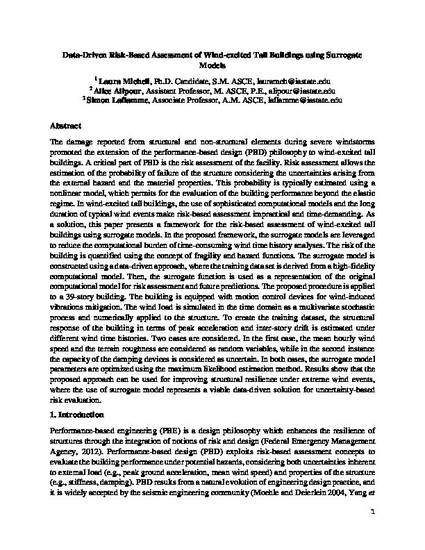
The damage reported from structural and non-structural elements during severe windstorms promoted the extension of the performance-based design (PBD) philosophy to wind-excited tall buildings. A critical part of PBD is the risk assessment of the facility. Risk assessment allows the estimation of the probability of failure of the structure considering the uncertainties arising from the external hazard and the material properties. This probability is typically estimated using a nonlinear model, which permits for the evaluation of the building performance beyond the elastic regime. In wind-excited tall buildings, the use of sophisticated computational models and the long duration of typical wind events make risk-based assessment impractical and time-demanding. As a solution, this paper presents a framework for the risk-based assessment of wind-excited tall buildings using surrogate models. In the proposed framework, the surrogate models are leveraged to reduce the computational burden of time-consuming wind time history analyses. The risk of the building is quantified using the concept of fragility and hazard functions. The surrogate model is constructed using a data-driven approach, where the training data set is derived from a high-fidelity computational model. Then, the surrogate function is used as a representation of the original computational model for risk assessment and future predictions. The proposed procedure is applied to a 39-story building. The building is equipped with motion control devices for wind-induced vibrations mitigation. The wind load is simulated in the time domain as a multivariate stochastic process and numerically applied to the structure. To create the training dataset, the structural response of the building in terms of peak acceleration and inter-story drift is estimated under different wind time histories. Two cases are considered. In the first case, the mean hourly wind speed and the terrain roughness are considered as random variables, while in the second instance the capacity of the damping devices is considered as uncertain. In both cases, the surrogate model parameters are optimized using the maximum likelihood estimation method. Results show that the proposed approach can be used for improving structural resilience under extreme wind events, where the use of surrogate model represents a viable data-driven solution for uncertainty-based risk evaluation.
Available at: http://works.bepress.com/simon_laflamme/114/

This is a manuscript of the article Micheli, Laura, Alice Alipour, and Simon Laflamme. "Data-Driven Risk-Based Assessment of Wind-excited Tall Buildings using Surrogate Models." (2019).